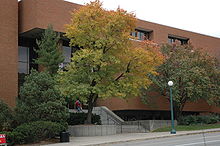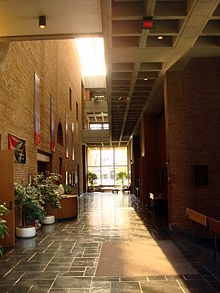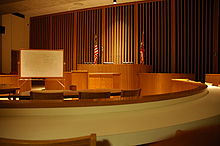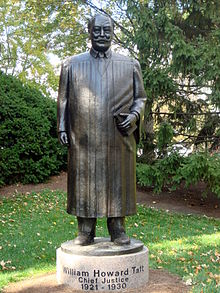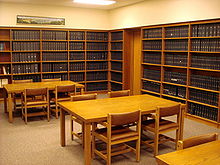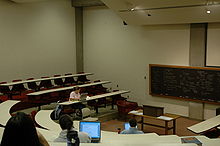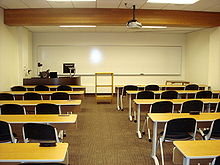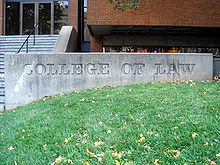- University of Cincinnati College of Law
-
University of Cincinnati
College of Law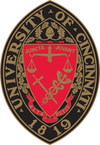
Motto Juncta Juvant ("Strength in Unity") Established 1833 Type Public (state university) Dean Louis D. Bilionis Students 385 Location Cincinnati, Ohio, USA Campus Urban Website www.law.uc.edu The University of Cincinnati College of Law is the fourth oldest continually running law school in the United States and a founding member of the Association of American Law Schools. It was started in 1833 as the Cincinnati Law School. Then-dean and future 27th President of the United States, William Howard Taft (1880), merged it with the University of Cincinnati in 1896.
The school is one of only seven American law schools, along with Yale Law School, Harvard Law School, Columbia Law School, the University of Virginia School of Law, the William & Mary Law School and the University of Missouri-Kansas City School of Law, to have produced both a President of the United States (William Howard Taft) and a Justice of the Supreme Court of the United States (both Taft and Willis Van Devanter). The school has also produced a Vice President of the United States, Charles G. Dawes, a Secretary of Commerce, Charles W. Sawyer, as well as numerous governors and U.S. congressmen.
Overview
Faculty
The UC College of Law's faculty includes several leading scholars in their fields. The faculty consists of 29 full-time employees and 27 part-time employees, creating one of the lowest student to faculty ratios in the country, 10:1. There are 10 endowed UC College of Law professorships currently. In 2005, the school announced the appointment of Louis Bilionis as Dean and Nippert Professor of Law at the University of Cincinnati College of Law. Bilionis was formerly the University of North Carolina School of Law's first Samuel Ashe Distinguished Professor of Constitutional Law.
Admissions
Admission to the College is quite competitive. In 2010, there were 1,823 applications and an entering class of 144 students. UC Law offers a full-time, day program only. Total enrollment is limited to 400 students. According to 2010 data, the median LSAT is a 161 and the median GPA is a 3.56. The 75th percentile for LSAT/GPA is a 162/3.80 respectively, while the 25th percentile for LSAT/GPA is a 157/3.36 respectively. There are 73 undergraduate schools represented in the 2010 incoming class. In terms of diversity, 20% of the students come from minority backgrounds.
The bar passage rate for first time Ohio bar examinees in July 2010 was 91%.[1]
Tuition/Financial Aid
Tuition and fees for the 2010-11 academic year was $20,946 for a resident and $36,526 for a non-resident. After one year, students are able to apply for residency and obtain the in-state tuition rate.
Rankings
In the most recent U.S. News & World Report rankings of top law schools (2011), UC Law was ranked 61st. From 1995 to 2002, UC Law was ranked in the top tier (top 50) of U.S. law schools by U.S. News & World Report.
Statue of former Dean William Howard Taft outside the College of Law. Taft went on to serve as President of the United States and Chief Justice of the United States.
Deans of the College of Law
Dean Years Served Timothy Walker 1833–1843 William S. Groesbeck 1844–1869 Charles L. Telford Maskell S. Curwen 1850–1868 Rotated among faculty 1869–1875 Rufus King 1875–1880 Jacob D. Cox 1880–1897 William H. Taft 1897–1900 Gustavus H. Wald 1900–1902 William P. Rogers 1902–1916 Albert B. Benedict 1916–1926 Merton L. Ferson 1926–1946 Frank S. Rowley 1946–1952 Roscoe L. Barrow 1952–1965 Claude S. Sowle 1965–1969 Samuel S. Wilson 1969–1970
1973*
1974–1978Edward A. Mearns, Jr. 1970–1973 Victor E. Schwartz 1973–1974* Jorge L. Carro 1978–1979* Gordon A. Christenson 1979–1989 Joseph P. Tomain 1989–1990*
1990–2005Louis D. Bilionis 2005–present *Acting
Library Services
The Robert S. Marx Library has 437,356 volumes with 237,352 titles and a full-time staff of 13 employees. The library also has two computer labs and a wireless network that is accessible throughout the College of Law building.
Clinics, Publications, and Student Activities
UC Law is home to several journals including the Human Rights Quarterly, University of Cincinnati Law Review, the Immigration and Nationality Law Review, and The Freedom Center Journal (FCJ), a joint publication between the law school and the National Underground Railroad Freedom Center.
The College of Law also offers a Moot Court program.
UC Law offers a variety of legal clinics and special programs. The Center for Professional Development works to develop students' legal research and writing capacities. The Lois and Richard Rosenthal Institute for Justice/Ohio Innocence Project works to free actually innocent inmates. UC's Corporate Law Center develops students understanding of corporate law. The Glenn M. Weaver Institute of Law and Psychiatry provides UC Law students, mental health providers, and others opportunity to examine the legal and psychiatric systems and their implications for criminals and the justice system. [2] Through the Center for Practice in Negotiation and Problem Solving students and practitioners can enhance their negotiation and problem-solving skills.
The College also offers joint degree programs in Law and Business, Community Planning, Political Science, Social Work, and Women’s Studies.
Urban Morgan Institute for Human Rights
The Urban Morgan Institute for Human Rights was established in 1979 to educate and train human rights lawyers and to promote and protect human rights in the international arena. It is the oldest endowed international human rights program for American law schools.[3]
The UMI emphasizes three areas: teaching, research and service. Students have the opportunity to participate in externships that can take them around the world-standing with human rights groups around the world fighting injustice; serving as election observers in South Africa; and, working to strengthen women's rights in foreign countries.
At the core of the UMI is the Human Rights Quarterly, recognized as the leading academic journal in the human rights field. The Quarterly covers the range of human rights matters encompassed by the Universal Declaration of Human Rights. Published by The Johns Hopkins Press, the Human Rights Quarterly is edited by the Institute's Director, Professor Bert B. Lockwood of the University of Cincinnati, College of Law.
University of Cincinnati Law Review
UC Law publishes the University of Cincinnati Law Review (founded 1927) which was the first law journal published by an Ohio law school. The Law Review is a quarterly publication produced by second and third-year law students. Each year, approximately 30 students are invited to join the Law Review as Associate Members.
The Moot Court Honor Board
UC Law's Moot Court Honor Board hosts two competitions throughout the academic year.[1] One is the LexisNexis Moot Court Competition, an entirely intramural competition held in the fall that serves as the basis for selecting new members to the Board. The second is the August A. Rendigs, Jr., National Product Liability Moot Court Competition held in the spring, which is open to law schools throughout the country. In addition, the Board sends teams of competitors to many regional and national moot court competitions.
The Corporate Law Center
The Corporate Law Center encourages the development of law students' and the legal and business communities' understanding of the issues involving corporate law. By developing programs to educate and train students, as well as provide assistance to attorneys, the Center positively impacts the legal and business communities-in Ohio, Northern Kentucky, and Indiana and the world. Established in the 1980s, the Center addresses issues of central concern to corporate attorneys, such as the fiduciary duties of managers, the relationship between managers and shareholders, and the relationship of the corporation to society. Central to its activities is the annual Corporate Law Symposium, which provides an opportunity for scholars, practitioners and law students from across the country to exchange ideas, debate issues, and discuss ongoing research and scholarship on current topics in the field.
Center for Practice
The Center for Practice was founded to enhance professional education for negotiations and problem solving. The Center's seminars, forums, workshops and courses draw upon work from a variety of disciplines, including law, behavioral science, and decision-science.
Lois and Richard Rosenthal Institute for Justice/Ohio Innocence Project
The Lois and Richard Rosenthal Institute for Justice/Ohio Innocence Project works for positive social and legal change in Ohio, Northern Kentucky, Indiana, and beyond. Founded in the aftermath of the racial strife and civil unrest that shook Cincinnati to its core in April 2001, the RIJ/OIP seeks to make a difference in the lives of wrongly convicted criminals, in government rulings, or in the community.
The RIJ/OIP focuses on research project and reports, the Ohio Innocence Project, and the Speakers Series. Participants engage in public policy research, working with UC law professors on issues that affect law and justice-from racism to race relations, from the environment to economics. The Ohio Innocence Project serves as "freedom fighters," working to free the wrongly convicted. UC Law's program has freed three wrongly convicted persons to date. The Speakers Series provides an opportunity to engage the public, politicians, and others on issues affecting urban justice.
The Lois and Richard Rosenthal Institute for Justice was founded by Gabriel J. Chin, Professor of Law, University of Arizona College of Law and Joseph P. Tomain, Dean Emeritus and Wilbert and Helen Ziegler Professor of Law, University of Cincinnati Law School.
Professor Mark A. Godsey serves as the Faculty Director. Staff attorneys include Jennifer Paschen Bergeron, Karla Markley Hall, and Carrie Wood.
The Lois and Richard Rosenthal Institute for Justice/Ohio Innocence Project is supported by Cincinnati and Ohio philanthropists.
Entrepreneurship and Community Development Clinic
At the ECDC, third year law students represent local small business owners and aspiring entrepreneurs on transactional legal issues critical to their success. Such services include assistance and counseling on entity selection and formation; regulatory compliance and licensing; trademark and copyright protection; lease review and negotiation; contract preparation, review, and negotiation; as well as any other legal issues confronting a small business. Students perform all work at the ECDC under the supervision of its director, Professor Lewis Goldfarb. The ECDC represents clients of limited financial means, including both for-profit and non-profit organizations, which cannot afford the legal services of the private bar. The ECDC determines eligibility for its services based on a completed “Application for Pro Bono Legal Assistance.”
The Center for Race, Gender, and Social Justice
The Center for Race, Gender, and Social Justice provides experiential learning, research, and other opportunities for interdisciplinary inquiry that enhance the vibrant intellectual life at the College of Law. The Center bridges theory and practice, forgse relationships with local, national, and global communities, and prepares students to take the lead in advancing justice. The Center's programs are the Joint Degree Program in Law and Women’s, Gender, and Sexuality Studies (WGSS), the Freedom Center Journal, and the Domestic Violence and Civil Protection Order Clinic.
Location
The College of Law is located in Cincinnati, Ohio which is the 62nd largest city in the United States--List of United States cities by population, while the Cincinnati-Middletown metropolitan area is the 24th largest in the country by population--United States metropolitan areas. The Greater Cincinnati area is home to over 685 law firms. Notably, Cincinnati's downtown is the site for the United States Court of Appeals for the Sixth Circuit courthouse, and also the courthouse for the United States District Court for the Southern District of Ohio.
Furthermore, Cincinnati is home to 10 Fortune 500 companies including being the headquarters for Procter & Gamble, Fifth Third Bank, GE Aviation, Macy's, Inc. and Kroger.
In their annual list, the Partners for Livable Communities has continued to name Cincinnati as one of the top ten most livable cities in the United States.
The College of Law is located at the corner of Clifton Avenue and Calhoun Street in the Heights neighborhood of Cincinnati.
Notable alumni
The period from 1925 to 1929 was a golden era for the school's alumni. During this time, UC Law alumni had significant influence in all three branches of the federal government. Charles G. Dawes was Vice President (and therefore also President of the Senate), Nicolas Longworth was Speaker of the House of Representatives, and William Howard Taft was Chief Justice of United States. Also during this time, alumnus Miller Huggins managed the New York Yankees to World Series championships in 1927 and 1928.
Name Year of Graduation Notable Accomplishments John D. Altenburg 1973 Major General and military lawyer (U.S. army ret.) appointed authority for military commissions covering detainees at Guantanamo Helen Elsie Austin 1930 A U.S. Foreign Service Officer and the first black woman to graduate from UC Law William M. Barker 1967 Chief Justice of the Tennessee Supreme Court Michael Ryan Barrett 1977 District Judge for the United States District Court for the Southern District of Ohio Sandra Beckwith 1968 Chief Judge and the first woman to sit on the United States District Court for the Southern District of Ohio Theodore Ted Berry 1931 First African-American mayor of Cincinnati, has been called "Mr. Cincinnati", advisor to Martin Luther King Jr. and pivotal attorney in the Civil Rights Movement for the NAACP Joseph Gurney Cannon attended, 1859 U.S. Congressman and Speaker of the United States House of Representatives (1903-1911) Samuel Fenton Cary 1837 U.S. Congressman representing Ohio in the U.S. House of Representatives (1867-1869), United States Vice Presidential candidate, prohibitionist Stan Chesley 1960 Nationally recognized attorney of Waite, Schneider, Bayless & Chesley Co., L.P.A., well-known for his expertise with class action lawsuits; has been referred to as "The Prince of Torts" Norton Parker Chipman 1859 Chief JAG Prosecutor at Andersonville, Secretary of the District of Columbia, U.S. Congressman, Author, and First Presiding Justice of the California Third District Court of Appeal Donald D. Clancy 1948 Former U.S. Congressman representing Ohio in the House of Representatives (1961-1977) and former mayor of Cincinnati James Beauchamp Clark 1875 U.S. Congressman and Speaker of the United States House of Representatives (1911-1919) Cris Collinsworth 1991 Former wide receiver for the Cincinnati Bengals and current television sportscaster for NBC Sunday Night Football Charles G. Dawes 1886 30th Vice President of the United States (1925-1929) and Nobel Peace Prize recipient James W. Denver 1844 Governor of the Kansas Territory (1857-1858), Secretary of State of California (1853-1855) and namesake of Denver, Colorado Joe Deters 1982 Ohio State Treasurer (1999-2005), Prosecuting Attorney of Hamilton County, Ohio (2005-present) Richard P. Ernst 1880 U.S. Senator from Kentucky (1921-1927) Judson Harmon 1870 Attorney General of the United States (1895-1897), Governor of Ohio (1909-1913) John David Holschuh 1951 Senior Judge of the United States District Court for the Southern District of Ohio Miller Huggins Manager of the New York Yankees, member of the Baseball Hall of Fame [4] Henry Thomas Hunt 1903 Mayor of Cincinnati (1912-1913) Charles Keating 1948 Founding partner of Keating, Muething & Klekamp; appointed to one of Richard Nixon's Presidential Commissions William J. Keating U.S. Congressman in the House of Representatives (1971-1974);partner of Keating, Meuthing & Klekamp Joseph P. Kinneary 1935 ret. Judge of the United States District Court for the Southern District of Ohio, The Joseph P. Kinneary U.S. Courthouse dedicated in 1998 Nicholas Longworth 1894 U.S. Congressman and Speaker of the United States House of Representatives (1925-1931) Charlie Luken 1976 U.S. Congressman and mayor of Cincinnati, Ohio (1984-1991, 1999-2006) Harold G. Maier 1963 International Law Scholar; former Counselor on International Law, U.S. Department of State William "Billy" Martin 1976 Prominent defense attorney of Washington D.C.; represented Marcia Lewis during the Lewinsky scandal, the parents of Chandra Levy, former Atlanta mayor Bill Campbell, former NBA player Jayson Williams, and most recently NFL Quarterback Michael Vick Lawrence Maxwell, Jr. 1875 United States Solicitor General (1893-1895) Edwin P. Morrow 1902 Governor of Kentucky (1919-1923) Edward F. Noyes 1858 Governor of Ohio (1872-1874) Atlee Pomerene 1886 Lieutenant Governor of Ohio (1910-1911) and United States Senator (1911-1923) Todd Portune 1983 Cincinnati City Council (1993-2000); Hamilton County Commissioner (2000-Present) William S. Richardson 1943 Former Chief Justice of the Hawaii Supreme Court (1966 - 1982); The University of Hawaii's William S. Richardson School of Law is named after him for his dedication to its establishment Thomas M. Rose 1973 District Judge for the United States District Court for the Southern District of Ohio Charles W. Sawyer 1911 Secretary of Commerce (1948 to 1953) David M. Smolin 1986 children's/human rights activist and law professor at Cumberland School of Law, Director of Cumberland School of Law's Center for Biotechnology, Law, and Ethics. Bob Taft 1976 Governor of Ohio (1999-2007) William Howard Taft 1880 27th President of the United States (1909-1913), 10th Chief Justice of the United States (1921-1930) and United States Solicitor General (1890-1892) Willis Van Devanter 1881 Associate Justice of the United States Supreme Court (1911-1937) References
- ^ Office of Bar Admissions
- ^ The Glenn M. Weaver Institute of Law and Psychiatry, http://www.law.uc.edu/academics/weaver_index.shtml
- ^ History of the Urban Morgan Institute, http://www.law.uc.edu/academics/morgan_history.shtml
- ^ HickokSports.com - Biography - Miller Huggins
External links
Websites and journals
- University of Cincinnati College of Law
- University of Cincinnati Law Review
- About the Human Rights Quarterly
- Immigration and Nationality Law Review
- About the Freedom Center Journal
- Securities Lawyer's Deskbook
- University of Cincinnati College of Law Student Bar Association
- University of Cincinnati College of Law Moot Court Honor Board
Professor blogs
- Professor Timothy K. Armstrong's Info/Law Blog
- Professor Marianna Brown Bettman's Legally Speaking Ohio Blog
- Professor Barbara Black's Securities Law Blog
- Professor Paul Caron's Tax Law Blog
- Professor Jacob Katz Cogan's International Law Reporter
- Professor Mark A. Godsey's Criminal Law Blog
University of Cincinnati Campuses Uptown West Campus • Uptown Medical Campus • Victory Parkway Campus (select College of Engineering and Applied Science programs) • Raymond Walters College • Clermont CollegeAcademics Academic Health Center (includes the Colleges of Allied Health Sciences, Medicine, Nursing, and Pharmacy) • McMicken College of Arts and Sciences (A&S) • Carl H. Lindner College of Business • Clermont College • College-Conservatory of Music (CCM) • Design, Architecture, Art, and Planning (DAAP) • College of Education, Criminal Justice, and Human Services (CECH) • College of Engineering and Applied Science • The Graduate School • College of Law • Blue Ash College • Social WorkAthletics Cincinnati Bearcats • Fifth Third Arena • Nippert Stadium • Paul Brown Stadium • Marge Schott Stadium • Armory Fieldhouse • Sheakley Athletic Complex • University of Cincinnati Bearcat BandsMedia Coordinates: 39°07′45″N 84°31′12″W / 39.12905°N 84.52010°W
Categories:- University of Cincinnati
- Law schools in Ohio
- Educational institutions established in 1833
- University of Cincinnati College of Law alumni
Wikimedia Foundation. 2010.

